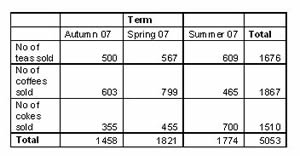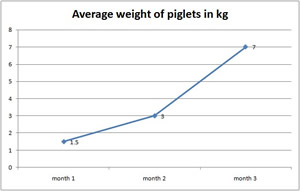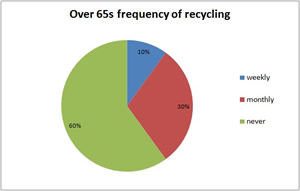Using graphical data
Sometimes words aren't the most effective way to communicate. Using graphs, tables and charts can help your reader to get a clearer picture of your research findings and how they compare with other data. Using drawings, diagrams and photographs can clearly present information that would be difficult to explain in words.
This page includes advice on when and how to use graphical information.
- Common forms of graphical information
- When to use graphs, tables and charts
- Layout, labelling and referring to figures
- Using drawings, diagrams and photographs
Top tip - If you need help understanding how to use or interpret statistical data, see Analyse This! for a beginner's guide to data analysis. Or look at the resources on the LearnHigher Numeracy, Maths and Statistics page.
Common forms of graphical information
| Tables are useful when you need to present a quantity of numerical data in an accessible format and you need to show exact numbers. |

Example of table |
|
|
|
| Line graphs are especially effective at showing trends (how data changes over time) and relationships (how two variables interact). |

Example of line graph |
|
|
|
| Bar charts/graphs are good when you want to compare discrete items. The bars can be vertical or horizontal. Making them different colours can help the reader to differentiate each result. |

Example of bar chart |
|
|
|
| Pie charts show the proportion of the whole that is taken by various parts. |

Example of pie chart |
|
|
|
| Drawings and diagrams can be used to reinforce or supplement textual information, or where something is more clearly shown in diagrammatic form. |

Example of diagram (By Eric Pierce) |
|
|
|
| Photographs can be useful as illustrations that help to explain what is being discussed in the text. |

Example of photo (By K. Kiser) |
When to use tables, graphs and charts
Graphical formats for data are used when they are a more useful way of conveying something about the information than text alone: when they 'add value' to the textual description of the data. The important thing is to use graphical information appropriately - not just because you think you ought to.
Consider carefully which is the best way to present your data. Read through the brief descriptions above, and choose the format that is most appropriate for what you are trying to convey. It should never be necessary to present the same information in two different graphical formats.
Layout, labelling and reference to
All graphs, charts, drawings, diagrams and photographs should be numbered consecutively as Figures according to where they come in the text (e.g. Figure 1, Figure 2, Figure 3 etc.).
All tables should be numbered using a separate sequence (e.g. Table 1, Table 2 etc.).
If your sections are numbered, you may number figures and tables in separate sequences that refer to the section number (e.g. in section 3 you would have, Figure 3.1, Figure 3.2 etc.).
Using drawings, diagrams and photographs
Complex processes and detailed descriptions can often be better represented visually in a diagram, drawing, or photo. For example, a very technical manufacturing system could be explained using a flow diagram.
Make sure all your images are large enough, and of a high enough quality, to be read easily and that they are labelled clearly to explain what they show.
You will need to reference any diagrams and photos you use if they have been created by another person.




 Site Design Copyright © 2021 LearnHigher.
Site Design Copyright © 2021 LearnHigher.